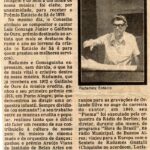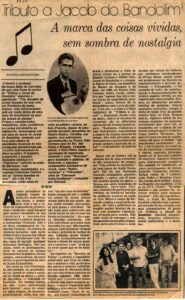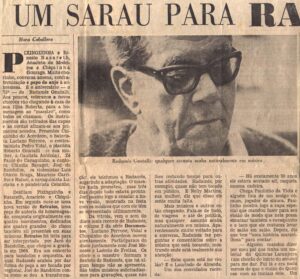- Radamés Gnattali won the 1979 Estácio de Sá Award for his services to Brazilian music, awarded by the Popular Music Council of the Museum of Image and Sound.
 O Globo (RJ) > Estácio and Golfinho 1979 went out to those who deserve it. For Sérgio Cabral
O Globo (RJ) > Estácio and Golfinho 1979 went out to those who deserve it. For Sérgio Cabral
- At the request of the mandolinist Joel Nascimento, Radamés transcribed the orchestral part of Retratos (1956) for regional choro ensemble. Based on the excellent interpretation by Joel and the young musicians who accompanied him at that time, the conductor was encouraged and began a new and final stage of his life, as a composer, arranger and pianist. In Rio de Janeiro, the Camerata Carioca [1].

Retratos – for solo mandolin, cavaquinho, 2 guitars, 7-string guitar, tambourine
I – Pixinguinha (trecho)
Joel Nascimento (mandolin), with Camerata Carioca
WEA – M990232-2 (1994)
- Sala Funarte, in Rio de Janeiro, presents, from October 24th to November 3rd, the show Tribute to Jacob do Mandolin, with script and direction by Hermínio Bello de Carvalho, with Radamés Gnattali (piano, composition and arrangements), Joel Nascimento (mandolin) and accompaniment of the spring Camerata Carioca. On December 13th and 14th, the show is taken to Salvador (BA) and presented at the Castro Alves Theater, in a short season..
 O Globo (RJ) > Tributo a Jacob do Bandolim By Antonio Chrysostomo
O Globo (RJ) > Tributo a Jacob do Bandolim By Antonio Chrysostomo
- At the end of 1979, the WEA record company released the albumTributo a Jacob do Bandolim, featuring mandolinist Joel Nascimento, alongside Radamés Gnattali, and newcomer Camerata Carioca. In the repertoire, in addition to songs by the honoree, Joel interprets the suite Retratos(1956), by Radamés.
- Funarte/INM launches the elepê Quinteto Villa-Lobos [2], with works by Brazilian composers, including the Suíte para flauta, oboé, clarinete, fagote e trompa (1971), by Radames Gnattali.
- Pianist Arthur Moreira Lima records at Copacabana, A grande música de Noel Rosa, in which he interprets the Concerto de Noel Rosa para piano e orquestra (1978), by Radamés Gnattali, conducted by the author.
- The record company Som Livre launches the album Iberê Gomes Grosso – Homenagem, , in which the great virtuoso interprets theSonata para violoncelo e violão (1969), and Radamés Gnattali, with Nelson de Macedo on guitar.
- Radamés composes:
- Concerto Carioca nº 2 for two guitars and chamber orchestra (transcription of the original for piano, double bass and drums, with orchestra, from 1964) – dedicated to Duo Assad.
- Retratos for solo mandolin, cavaquinho, two guitars, 7-string guitar and tambourine transcription of the orchestra part, from 1956, for choro ensemble) – dedicated to the mandolinist Joel Nascimento.
- The composer and broadcaster Haroldo Barbosa, one of the most brilliant minds of the so-called “golden age of radio”, dies in Rio de Janeiro (RJ), alongside Almirante, José Mauro, Paulo Tapajós and Radamés Gnattali.
- Beginning of the government of the last president of the period of Brazilian military dictatorship, General João Baptista de Oliveira Figueiredo. Political opening is promoted, the AI-5 ceases to be in force. The Amnesty Law is passed and several exiles return to the country[3].
- Congress approves the party reform that extinguishes ARENA and MDB.

